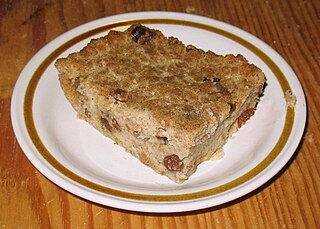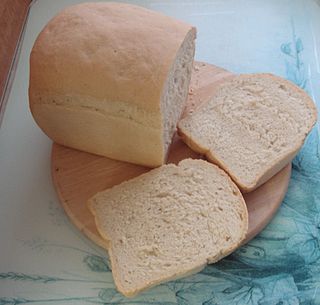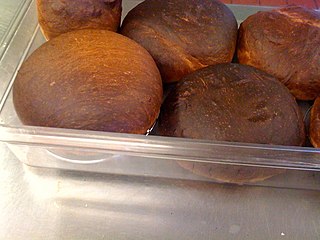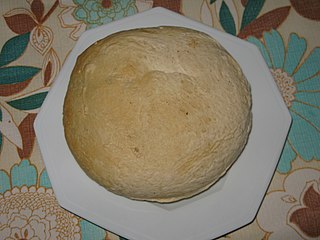
Bread pudding is a bread-based dessert popular in many countries' cuisines, made with stale bread and milk or cream, generally containing eggs, a form of fat such as oil, butter or suet, and depending on whether the pudding is sweet or savory, a variety of other ingredients. Sweet bread puddings may use sugar, syrup, honey, dried fruit, nuts, as well as spices such as cinnamon, nutmeg, mace, or vanilla. The bread is soaked in the liquids, mixed with the other ingredients, and baked.

Baking is a method of preparing food that uses dry heat, typically in an oven, but can also be done in hot ashes, or on hot stones. The most common baked item is bread but many other types of foods are baked. Heat is gradually transferred "from the surface of cakes, cookies, and breads to their center. As heat travels through, it transforms batters and doughs into baked goods and more with a firm dry crust and a softer center". Baking can be combined with grilling to produce a hybrid barbecue variant by using both methods simultaneously, or one after the other. Baking is related to barbecuing because the concept of the masonry oven is similar to that of a smoke pit.

Cake is a form of sweet food made from flour, sugar, and other ingredients, that is usually baked. In their oldest forms, cakes were modifications of bread, but cakes now cover a wide range of preparations that can be simple or elaborate, and that share features with other desserts such as pastries, meringues, custards, and pies.

Pastry is a dough of flour, water and shortening that may be savoury or sweetened. Sweetened pastries are often described as bakers' confectionery. The word "pastries" suggests many kinds of baked products made from ingredients such as flour, sugar, milk, butter, shortening, baking powder, and eggs. Small tarts and other sweet baked products are called pastries. Common pastry dishes include pies, tarts, quiches, croissants, and pasties.
A spiced bun is a sweet bun to which spices were added during the making process. Common examples are the hot cross bun and the Jamaican spiced bun.

Gooey butter cake is a type of cake traditionally made in St. Louis, Missouri. It is a flat and dense cake made with wheat cake flour, butter, sugar, and eggs, typically near an inch tall, and dusted with powdered sugar. While sweet and rich, it is somewhat firm, and is able to be cut into pieces similarly to a brownie. Gooey butter cake is generally served as a type of coffee cake and not as a formal dessert cake. There are two distinct variants of the cake: the original St. Louis, MO Bakers' gooey butter and a cream cheese and commercial yellow cake mix variant. The original St. Louis, MO Bakers' gooey butter is believed to have originated in the 1930s. It was made with a yeast-raised sweet dough on the bottom.

Portuguese sweet bread is a bread made with milk, sugar, eggs, yeast, flour and sometimes lemon peel to produce a subtly sweet lightly textured loaf or rolls. A slightly different recipe is made during Easter that is known as folar and often contains a hard-boiled egg.

A Swiss roll, jelly roll, roll cake, cream roll, roulade or Swiss log is a type of rolled sponge cake filled with whipped cream, jam, or icing. The origins of the term are unclear; in spite of the name "Swiss roll", the cake is believed to have originated elsewhere in Central Europe, possibly Austria. It appears to have been invented in the nineteenth century, along with Battenberg cake, doughnuts, and Victoria sponge. In the U.S., commercial versions of the cake are widely known under brand names like Ho Hos, Yodels, and Swiss Cake Rolls. A type of roll cake called Yule log is traditionally served at Christmas.

Entenmann's is an American company that manufactures baked goods and delivers them throughout the United States to supermarkets and other retailers for sale to the public. The company offers dessert cakes, donuts, cookies, cup cakes, loaf cakes, pies, cereal bars, muffins, Danish pastries, crumb cakes, and buns among other baked goods. In the past several years, they have added designer coffee flavors along with scented candles to their product line in an effort to broaden its appeal.

Lángos or langallo is a typical Hungarian street food. Today it is a deep fried flatbread, but in the past it was made of the last bits of the bread-dough and baked at the front of the brick or clay oven, to be served hot as the breakfeast of the bread-baking day.

Cuban bread is a fairly simple white bread, similar to French bread and Italian bread, but has a slightly different baking method and ingredient list ; it is usually made in long, baguette-like loaves. It is a staple of Cuban-American cuisine and is traditionally the bread of choice when making an authentic Cuban sandwich.

Pandesal is a common bread roll in the Philippines. It is made of flour, yeast, sugar, oil, and salt.

Toast is bread that has been browned by exposure to radiant heat. The browning is the result of a Maillard reaction, altering the flavor of the bread and making it firmer so that it is easier to spread toppings on it. Toasting is a common method of making stale bread more palatable. Bread is often toasted using a toaster, but toaster ovens are also used. Pre-sliced bread is most common.

Faluche is a traditional bread in the Nord-Pas-de-Calais region of northern France and the Tournai region of southern Belgium.

Mexican breads and other baked goods are the result of centuries of experimentation and the blending of influence from various European baking traditions. Wheat, and bread baked from it, was introduced by the Spanish at the time of the Conquest. The French influence in Mexican Bread is the strongest. From the bolillo evolving from a French baguette to the concha branching out from a French brioche even the terminology comes from France. A baño maría, meaning a water bath for a custard type budín or bread pudding comes from the French word bain marie. While the consumption of wheat has never surpassed that of corn in the country, wheat is still a staple food and an important part of everyday and special rituals. While Mexico has adopted various bread styles from Europe and the United States, most of the hundreds of varieties of breads made in the country were developed here. However, there is little to no baking done in Mexican homes; instead, Mexicans have bought their baked goods from bakeries since the colonial period.

A babka is a sweet braided bread or cake which originated in the Jewish communities of Poland and Ukraine. It is popular in Israel and in the Jewish diaspora. It is prepared with a yeast-leavened dough that is rolled out and spread with a filling such as chocolate, cinnamon, fruit, or cheese, then rolled up and braided before baking.

Limpa is a sweet Scandinavian rye bread, associated with Swedish cuisine. It is a yeast-leavened spice loaf, sweetened with brown sugar and molasses which comes in a large variety in regards to whether or not butter-enriched, and which spices are being used. Traditional bread spices are anise, caraway, fennel seeds and bitter orange, Typically baked during the Christmas season, the festive wort breads / loaves I are flavoured with spices like anise, caraway and fennel seeds, and often orange rinds, raisins or sultanas, and dark beer, in addition to the wort. Its distinct taste and look is in a large part due to the addition of wort to the dough, making it similar to a malt loaf. It is a typical dish for a traditional Christmas Eve smörgåsbord or julbord. Limpa bread pairs well with jams and jellies, or cream cheese.

















